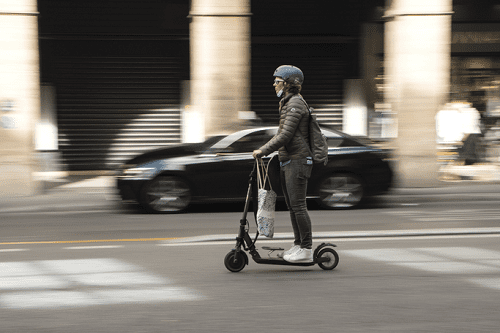Tips for safe ownership of e-bikes & e-scooters

Authored by Covéa
E-bikes have gained much popularity in recent years, with annual UK sales reported to have tripled in the last 5 years to around 160,000 units.
It’s easy to see the appeal of these – casual bike riders can experience that simple ‘wind in the hair’ joy that comes from cycling at 15mph while exerting only a modest amount of pedalling effort. Food couriers can zip from delivery to delivery with far less physical endurance than would be required with a standard bicycle. Plus, major fuel savings can be made too, with the rising cost of living considered to be a key motivator behind the sales growth seen in recent times (YouGov poll, 2022).
On the flipside, we’re increasingly hearing about fires caused by overheating lithium-ion batteries in e-bikes as well as e-scooters. In London alone, the London Fire Brigade (LFB) attended 87 e-bike and 29 e-scooter fires during 2022, which approximately equates to one incident every 3days. This figure is reported to have risen in 2023, as the LFB has already attended 81 e-bike and 17 e-scooter fires so far this year. If this frequency continues it will mean over a 50% increase in the number of e-bike and e-scooter fire incidents compared to last year.
The worst of these incidents have involved loss of life due to e-bike or e-scooter fires breaking out while the items are being stored/charged in the only safe route of exit from a home, or in communal areas and corridors in blocks of flats, thereby trapping occupants inside.
When lithium-ion batteries become overheated they can enter an uncontrollable state of self-heating commonly referred to as thermal runaway. This can quickly lead to emission of toxic smoke and the outbreak of a very intense and rapidly developing fire which, reportedly, can be difficult to extinguish. A growing concern is the purchase of cheaper additional batteries, potentially incompatible chargers and e-bike conversion kits (used to convert a standard pedal cycle into an e-bike) from online marketplaces, which may not adhere to UK safety regulations. These are more likely to fail and pose an increased risk of fire.
When it comes to e-bikes and e-scooters, some of the most important risk management guidance includes:
Only buy e-bikes, e-scooters, chargers and batteries from a reputable seller.Allow batteries to cool down after use before recharging and avoid exposing them to extreme temperatures.Don’t leave batteries charging unattended or while asleep and, ideally, install smoke and heat alarms in the charging area.Only use manufacturer-approved products and carefully check that separate components, such as batteries and chargers, are compatible with one-another.Avoid storing or charging e-bikes/e-scooters in the main (or only) exit route from the home and, wherever possible, store within a garage or shed, rather than inside the home.
Our Executive Home and Executive Plus policies provide cover for e-bikes with a maximum speed of 15.5mph and maximum power output of 250 watts. E-scooters up to the same maximum speed are also covered as long as their use complies with current UK law and they are not left unsecured whilst unattended away from the home.







